Amar Bakshi caused a stir in his parents' suburban D.C. neighborhood back in 2014 when he had an empty 20-foot-by-8-foot shipping container delivered to their backyard. Rumors swirled that Bakshi was residing in the container, and his parents were confronted with complaints about the eyesore. One neighbor took particular exception to the container's presence, calling first the police and later an FBI tip hotline, reporting the container as a possible threat to homeland security.
"I had painted it to read 'Portal to Tehran,' and I guess it looked suspicious," Bakshi says, good-humoredly. "A very friendly FBI agent called, and when I explained what it was, he was really excited and wanted to take part in it when it launched. I don't know if he ever came by, but he was a nice guy."
For the record, Bakshi, SAIS '13 (MA), never lived in the shipping container, and it most certainly wasn't a security threat. Rather, the container was the first iteration of Portals, an art installation that has since grown into an international network of structures outfitted with audiovisual technology for life-size video calls between strangers. More than 150,000 people have had one-on-one conversations through Portals since the project launched, including former U.S. Secretary of State John Kerry, philanthropist Melinda Gates, Google co-founder Sergey Brin, and former President Barack Obama.
The idea for the project came to Bakshi while he was in law school, reminiscing about the spontaneous conversations he'd had while working as a reporter. Technology, he noticed, afforded him an unprecedented level of interconnectedness, and yet, he says, he rarely struck up conversations with people around him anymore. Bakshi, founder and creative director of arts and technology collective Shared Studios, launched the project with his longtime friend Michelle Moghtader, whom he met while working for Fareed Zakaria at CNN.
Debuting in an art gallery on the Lower East Side of Manhattan in February 2015, the first Portals exhibition was an immediate success, with more than 500 curious New Yorkers striking up conversations with strangers in an identical Portal set up by Moghtader in Tehran.
"People would spend hours inside—they'd come out crying or giddy, just really emotional," Bakshi says. "They'd come out with all these ideas, too: I want to bring my grandmother, I want to bring my high school class, I want to do an art collaboration. It's a really rich and diverse community that's attracted to these Portals."
Moghtader, who had been on assignment in the Middle East for Reuters, says there were few direct channels between the U.S. and Iran at that time. "I am Iranian-American, so it felt very personal to me to bring together people who are close to me to speak directly."
Awesome experience with folks in Herat Afghanistan @SharedStudios Portal @MarymountNY #CODE #GlobalEd pic.twitter.com/mXOBUEYOHU
— Eric Walters (@EWaltersScience) February 2, 2018
The Portals accomplish complex technical tasks while masquerading as something simple. Painted in a luxurious shade of dark gold—to evoke that which is sacred, Bakshi says—the containers' walls, floors, and ceilings are fully carpeted to absorb noise and create the illusion of spatial continuity. Using Shared Studios software, the containers "call" one another, recording participants using a series of microphones and a discreetly placed camera that's specially calibrated to capture a full room without optical distortion. The life-size video screens and identical spaces cause the screen separating participants to seemingly dematerialize. "The darkness helps bring out the person you're talking to," Bakshi says. "These are all intentional choices that help you forget you're on camera."
Portals currently operate in 40 locations around the world, including Iraq, Germany, Myanmar, Mexico, Jordan, Afghanistan, and the U.S., with new locations opening every month. Funding is provided on a project-by-project basis from organizations including the U.S. State Department, the United Nations, UNICEF, and the Aspen Ideas Festival. In addition to the shipping containers, there are indoor Portals that can be assembled from modular building pieces, as well as inflatable structures that can be compacted to fit into a suitcase. Free-standing, 8-foot-tall video screens, which include the custom camera and audio equipment, offer a more impromptu interaction between passersby that can be set up within an hour.
"Getting to know people from another place complicates any simplistic vision of the world," Bakshi says. "It gives you a human connection to a place that is more than just a concept or an idea or a fear."
These days, the Portals are built on-site at the host locations, but Bakshi says his parents' backyard is always available for tune-ups. When a Portal does make an appearance, the neighbors now stop by to pay it a visit. Well, all but one. From that neighbor, the one who called the FBI, "we never heard a peep again," Bakshi says.
Posted in Arts+Culture, Politics+Society, Alumni
Tagged alumni, art, politics. culture










